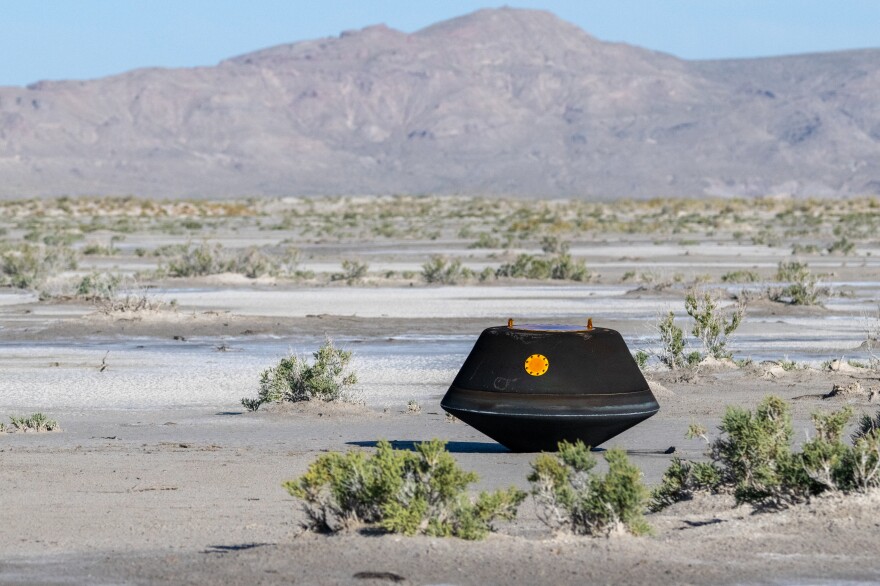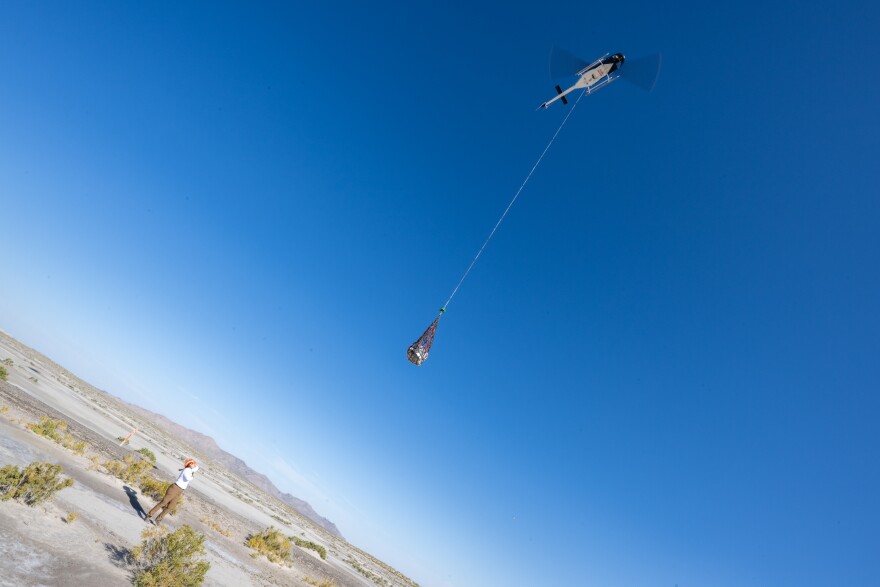As the sun rose over the Utah Test and Training Range, the crisp September morning sky shifted gradually from deep blue to rosy pink. Outside an airplane hangar, a crowd of reporters and scientists milled around, ready to welcome an extraterrestrial care package.
The deep rumble of helicopters filled the air as, one by one, they took off.
“It’s hard to believe we’re finally here for real,” said systems engineer Anjani Polit.
The recovery team members in the helicopters are there to collect the OSIRIS-REx sample return capsule, which is about the size of a large truck tire and has traveled millions of miles and seven years to end on a stretch of tan, dusty Utah desert. Inside is what scientists estimate to be 8.8 ounces of asteroid, or about enough to fill one measuring cup.
“And maybe that doesn’t seem like a lot but that is four times the requirement that we had, and there is so much we can do with even a single grain of the material,” said Polit.

OSIRIS-REx launched in 2016. Later, in 2020, it played space tag with the near-earth asteroid Bennu. The craft only touched the surface for a few seconds, since instead of hitting solid ground like the team expected, its arm sank straight through like being swallowed up by a ball pit.
Shaped a little like a spinning top and roughly the size of the Empire State Building, the asteroid is thought to be carbon-rich. Scientists are hopeful once they have some of it in hand, it can reveal more about our solar system’s origins, especially life.
“I mean the important thing here is that these samples will be clean, uncontaminated, really pristine fragments from the early solar system,” said NASA scientist Daniel Glavin. “It’s the first time we’ll be able to look for the building blocks of life and trust the results, right, that this is not contamination. These things really formed in space.”
There is another reason studying Bennu is important. It’s one of the asteroids scientists have identified as a potential hazard.
“In 2182, Sept. 24, there’s a very small chance –– one in 2,700, less than 0.05% chance –– that [Bennu] could hit Earth. And so it’s not zero,” said Glavin.
That’s exactly 159 years to the day that the Bennu sample was recovered.
“So if we have to design a mission to go deflect an asteroid like Bennu, we’re going to be better prepared to do that,” he said.

As the sample capsule careened into Earth’s atmosphere, the mission team was quiet. Data and projections showed it was going right where it should. Perfect.
At 20,000 feet, the full creamsicle orange and white parachute unfurled. It slowed the capsule to 11 miles per hour. Almost perfect. Officials would later say the capsule popped its chute four times higher than expected.
And then gently, it fell to earth, landing nose down in the Utah sand. Perfect.
After it was swarmed by the recovery team, a helicopter hooked the capsule with a long line to carry it to a clean room of anxious scientists at the Dugway Proving Ground.
Dante Lauretta, the principal investigator for the mission and a professor at the University of Arizona, climbed out of another helicopter, gave a big thumbs up and told reporters it had been a long night.
“I hardly slept, tossed and turned, got up and graded student essays, actually, just to kind of get my mind off of things,” he said with a laugh.

It was the culmination of about 20 years of work.
“I don’t think I’ve really processed how much stress I’ve been carrying over the last couple of decades building up to this moment. So it’s starting to release, but I cried like a baby in that helicopter when I heard that the parachute had opened and we were coming in for a soft landing. It was just an overwhelming moment for me,” said Lauretta.
From here, the sample goes to the Johnson Space Center in Houston, Texas to be opened and distributed to partner research organizations. Some of the space rocks will be saved so that future scientists with better equipment can study them.
As for OSIRIS-REx, the spacecraft’s mission continues. It changed course early Sunday, zipping away from our blue marble to study another near-Earth asteroid named Apophis.






